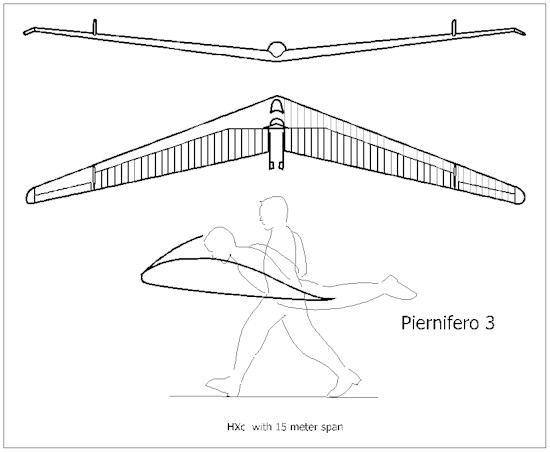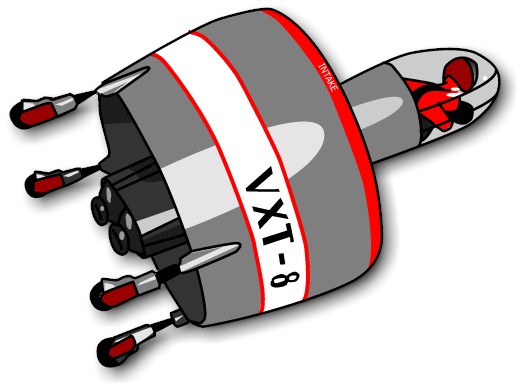|
|||
| Akaflieg Stuttgart
built the FS17, a research glider. The study had as purpose checking if a proned pilot
could endure higher g-forces. Lets first explain to the inexperienced what g-forces are.
G-forces are created in airplanes when they make turns or pulls up. Sometimes these forces are that high, one can’t barely move his hand. You can compare it with making a tight turn with a car. The people inside the car get "pushed" sideways. In a airplane the pilot get pushed downward (positive g-forces) or upwards (negative g-forces). In normal life the g-force is 1. If making tight turns or pulling up, the g-forces increase and your hand starts to weight more. At a certain level you can’t move your hand. It seems like it is glued to the armrest. Lying on your belly doesn’t make you move your hand, but it helps not to pass out. Yes, sometimes the g-forces are that high that the blood "gets sucked out of your brain". Your vision gets black and in a further phase you pass out (= gets unconscious). Lying on your belly reduces the height between your head and your heart. So the heart doesn’t need to pump the blood as far upwards as it needs to do in seated position. Reducing this height makes a pilot pass out at higher g-forces.
Here you can clearly see the difference between feeding a brain of a seated pilot and of a proned pilot. Black-outs are much experienced during WW II. Dive bombing, a technique much used in WW II, always ends up in a pull-up at the end of the bomb-run. Fighter pilots having a dogfight sometimes make sharp turns, they were also having black-outs. So, looking for a solution for this problem seemed obvious at that time. I got the following information about the Akaflieg FS 17 from Peter F. Selinger: "The FS 17 is a very small wooden sailplane. The students started construction in 1937 with a maximum load of n.j=14. The open fuselage in the cockpit area required special enforcements to spend the pilot a safe "bed". They made first flight 21st March 1938 at the Teck gliderfield nearby Dettingen/Teck, which is a small village south of Kirchheim/Teck. Neither in the book 50 years Akaflieg Stuttgart, nor in other publications I have, there was a complete 3-view, nor dimensions. The maiden flight pilot reports, that the prone position didn't caused any problems, except the arm should have a longer rest to reduce PIOs on the elevator. It's to suppose that the input to make such a plane is the result of medical research, that people could withstand high g-load far better in prone position, higher gs as well as these higher gs for a far longer time. But I don't know who initiated the construction." Reimar Horten did know about this study. He mentioned it to Jan Scott as his inspiration to use proned pilots in his own designs. But Reimar used a semi-proned position. The upper body of the pilot was placed at 30° from the horizontal. This made that the pilot didn’t need to turn his head that much upwards, as in the proned position, to look forward. It made the position less tiring. Sometimes a radical idea won’t get into production because it gets critics out of prejudgment from higher placed persons. Well, that was not the case with the Horten IV because it was designed and build …without official approval or knowledge. You probably wonder why the Horten brothers wanted to use this "obsolete" pilot technique. Besides the ability to withstand higher g-forces they had 4 other reasons. It found these in the book "Nurflugel" by Reimar Horten and Peter F. Selinger (ISBN 3-900310-09-2)(part German, part English).
I guess that the main reason was visibility. The Horten brothers always did use wings with backwards sweep (for more explanation, go see flying wings). When you place a pilot near the center of gravity (CG), which is normally done in gliders, the pilot is placed further backwards in relation to a pilot in a straight wing airplane. The reason is that the CG is placed more backwards in backswept airplanes. This makes that the pilot needs to look over a large portion of the wing. Looking over the wing is difficult, but necessary during landing. This must have been a problem to the Horten brothers too. The Horten Ho II had a large transparent leading edge part, which was wider than the basic cockpit. It gave the reclined pilot (later seated) a better view forwards and sideways. But it must have weighted a lot in relation to a classic wing leading edge. Placing a pilot in proned position in a backswept glider makes the head of the pilot shift more forwards, more towards the leading edge. The pilot has less wing to look over. It is now even possible to place a small transparent part on the lower side of the wing to have superb vision downwards. I placed a question about the Horten IV to Mr.
Scheidbauer,
one of Hortens test pilots. He did answer through Peter F. Selinger (member of the
Nurflugel Mailinglist): "he told me that he appreciated the downward view
specifically at winch-launch. He said, riding into the sky nearly vertically and seeing
the Not only was the body of the pilot in a new position, his arms were also placed in a new way. The arms were placed sideways and nearly at the same height of the shoulders. In this position it would be hard to push or pull a stick, it is a unpleasant wrist-movement. Horten solved the problem by using a ramshorn shaped handle-bar. Pitch control was done by sliding it forwards or backwards. It solved the problem. Control forces were light at all speeds. The Horten H IV had small sized instruments, so the vision would not be obscured by large instruments. The further development of the Ho IV, the Ho VI, had regular sized instruments but they were placed in the D-tubes (frontal portion of the wing) of the wings and were viewed using a mirror. I read about flights with the H IV mentioning flights of 10 hours! So long flights could be made in this strange position. Somewhere I did see a picture of a Horten sitting on his knees, showing the pilot position to Reichsmarshall Göring. I guess it shows that the Horten Ho IV got know and that this modern sailplane and its pilot position made good impressions to the higher placed. I found several other German projects with proned pilots. But all had a later date. So I guess once the other German manufacturers heard about the Horten Ho IV, they got thinking about proned pilots too.
The DVL (Deutsche Versuchanstalt für Luftfahrt) gave a order to build a powered aircraft. It was built by FFG Berlin and was named the Berlin B9. It flew spring 1943. It could withstand 22g!. The configuration was a lowwing twin engine airplane. It looks kind of usual except the cockpit. The fully glazed cockpit gave the pilot superb view between 30° below the horizontal to 40° above the horizontal. There was no view to the rear. this kind of view was found to be ideal for 4 types of airplanes:
www.luft46.com has the full story on the Berlin B9. Go see the prototypes section. This research airplane test result must have been known to other firms, because... I found a German dive bomber, a fast, small fighter and a fast reconnaissance airplane. The DFS 228 started its life as a idea in the beginning of WW II. The idea mentioned the use of a rocket propelled sailplane, which could climb to extreme heights and then soar for a long time. It was meant as a reconnaissance airplane which would be uncatchable by the enemy. In 1941, the Technischen Amt of the RLM gave the specification to DFS (Deutsches Forschuninstitut für Segelflug (German researchcenter for gliding). The designwork began, but stopped due to low priority. In 1943, the idea got into higher priority and the work was recommenced. The result was a midwing glider with a classic layout but with a remarkable cockpit. the cabin was pressurized and the pilot lay in a proned position. There were only 5 small transparent parts in the cabin. One circular part in the front and 4 smaller rectangular parts more backwards (two on each side). Why did they use a proned pilot? It puzzled me. I measured the height of the cockpit using a 3 view of the DFS 228 and came to 1,25 m (4 feet 1 inch). That is high enough to place a seated pilot (maybe a bit reclined). OK, the cockpit wall is thicker due to the pressurized construction, but still I don't think that it was for a smaller cross-section that they used a proned pilot. I guess the reason can be found in the transparent parts. At these heights the thickness of that glass is higher to withstand the pressure. The smaller they are, the lesser the thickness of the glass has to be to withstand the pressure and that makes the glass less heavy (smaller and less thickness). I guess that easy construction and reduction of weight were the basic ideas to choose a proned pilot here. But let's not forget the advantage of the view downwards. It must have been a advantage for this reconnaissance airplane. At www.luft46.com I did find a picture of a DFS 228 pilot lying in his cockpit. I could see the pilot stretching his arms downwards. He was piloting in this position. One thing is for sure. A proned pilot can place a lot of instruments under him. The floor of the cockpit can be filled with instruments (as long as they are within reach). The side of whatever the pilot is laying on can be filled with devices too (if the sidewall of the cockpit is a bit further away). OK, all instruments or levers will not be within view, but do you need to look for the gear stick in your car to use it (only valid on cars without automatic gear)? I guess not after some training. Proned pilots can have more instruments and levers around them than a classic seated pilot, I believe. But they need blind operation whenever you need to be forced to look forwards (landing for instance). But you can always choose to place items related to landing within view and the other stuff out of your forward view. Don't you need to turn your head too if you want to adjust your car radio (only valid on car radios without steeringwheel controls). The DFS 228 never got operational due to the end of the war, but two prototypes were build and the production of 10 DFS 228 A-0 had already started. Plans were made for a further development, the DFS 346, which was planned to be supersonic (Mach 1.9) at 66.000 feet (20,1 km).
Henschel 132, a dive bomber with a proned pilot. The Henschel HS 132 looks similar to the better known Heinkel He 162. It has its jet-engine on its back for better maintenance, it has a tail consisting out of a horizontal part which is a bit angled upwards and at each end a vertical rudder. The difference can be found in its function and its cockpit. the He 162 is a fighter, the HS 132 is a bomber. The pilot of the HS 132 is in a proned position. Why? Well, if you read the 5 reasons to use a proned pilot mentioned by Horten, you would remember the higher G-forces a pilot can endure. The book "The Warplanes of the Third Reich" by William Green mentions that seated pilots black out (vision disappear due to less blood in brains) at 4-5 g, a proned pilot black out at 10-11 g. Dive bomber-pilots sure need to endure g-forces in their last part of the bombing, namely the pull-up. That and the superb vision downward (see test results Berlin B9) are the reasons to use a proned pilot in the Hs 132. The Hs 132 V1 was nearly assembled for initial flight trials when the factory was captured by Soviet forced. The Gotha factory was building the radar-equipped Horten Ho IX, a for that time futuristic jet-engine flying wing. Using the knowledge they gathered from the construction of these now named Gotha Go 229 (other name used for the Horten Ho IX), they made a proposal for a fighter, the Gotha P60. The P60 used nearly the same wing layout as the Go 229. The first proposal, the P60A, used a cockpit with the crew (2) in a proned position laying side-to-side. There were no extra bulbs needed to place the crew. All fitted inside the wing. Well, not exactly all. The engines of the P60 were placed outside the wing. One on top of the central part, one under the central part. Maybe this was done for better maintenance of the engines. Steve Reichmuth remarked that the lower engine might cause problems due to ingestion of foreign objects during take-off and landing. I bet he is right. Just look at the front wheel. What is right behind it? Yes, the lower engine. What will happen if the front wheel hits a small rock or dirt? ... Trouble, because jet-engines don't like to eat things like that. That is enough about the engines, this page is about proned pilots.
A few drawings of the
Gotha P60A I received from Romain Schoenenberger. The second proposal, the Gotha P60B, no longer has the proned pilots. I did ask myself why. The answer seems to be that Gotha needed to make a simplified cockpit. Maybe they wanted to speed up development or production. Gotha got approval to start building the P60B-prototype, but work was stopped in favor of the final proposal, the P60C. The most remarkable German WW II airplane is definitely (to me) the Blohm und Voss BV 40. Let's follow the thoughts of its designer, Dr. Ing. Richard Vogt (known for several other unusual designs, go see asymmetric airplanes): the front area of a Focke-Wulf Fw 190 (about 1,6 m2 (17 sq. ft.)) is a capable target of a average gunner at a range of more than 914 m (1000 yards). The reason for this large frontal area is the size of the engine. So reducing the chance to be hit can be done by reducing the frontal area. And reducing the frontal area can be done by ... placing no engine! The idea of the BV 40 is born.
He must have thought about other ways to reduce the frontal area even more. So the decision to use a proned pilot was not far away. Richard Vogt believed that the tiny "glider-fighter" would be invisible to the gunners before the BV 40 struck with its 30 mm (1.18 inch) cannons. The pilot was to be positioned behind a 120 mm (4.7 inch) armor-glass windscreen and he was further protected with heavy metal sheets. The airplane was made mostly out of wood. The general layout was classic (highwing with classic tail) and the instruments were kept to a minimum. Simplicity all over.
The BV 40 was to be towed by a fighter. It took off on a jettisonable trolley and landed on a skid. The BV 40 had to deliver as much as possible damage on its single pass. That is why it had two 30 mm cannons. Several prototypes were made. Flight characteristics were good, but the stall was terrible. At 140 km/h (87 mph) the plane fell out of the sky without warning. But the plane got through the first tests with a idea that handling was good enough. One thing I read is the opposite of what Horten said. The BV 40 V6 was towed from Stade to Wenzendorf behind a Bf 110 as a long flight test. The pilot did complain about the proned position as tiring. Maybe the difference with the Hortens can be found in the fact that Horten did use semi-proned positions and that the pilot of the BV 40 was fully proned. The pilots of the Horten gliders didn't have to turn their head that much upwards as a fully proned pilot. Heinkel made also a airplane with a proned pilot, the Heinkel P.1077 Julia. It was a rocket-powered fighter. Like the BV 40, simplicity was the main goal (except for the engine). It was a small high wing aircraft with a tail like the Hs 132 (but not angled upwards). Wood was the main construction material. The prototype was build only using normal workbenches of carpenters. Like I said … simplicity. Take-off was to be made vertically and the Julia landed on tandem skids (two behind each other, the first could be lowered and both had a shock-absorber). A second version was designed using a seated pilot. But because the chief-designers of this project couldn’t come to a compromise, both versions would be build. Production was not without problems. Not due to the design, but due to the situation of Germany in the war. I didn’t find any record of flights with a Julia. So I assume that the prototypes never were finished. The classic question I ask again is "Why did they use a proned pilot?" I cannot find the reason. Ok, the version with the seated pilot is a bit higher. It might have been that. But I could also be that the designers were influenced by the test result report of the Berlin B9 (I don’t know how much this paper got spread within the aviation firms). It mentions a proned pilot as good for a fighter with speed superior to their opponents. Remember: the Julia is powered by a rocket-engine. The rocket-engine in the Messerschmitt Me 163 Komet made it uncathable during powered flight. But the Me 163’s were shot down during its glide downwards. Would the Julia have suffered the same fate? All the W.W.II planes mentioned till now were German. But there were experiments with proned pilots too in the USA. But how did they come to this idea? I have my own theory. But I cannot prove it. It is based on something I read in the book "Nurflugel". It mentions a flight with the H II by Reimar Horten. The pilot saw another plane with a photographer inside. The next month the Horten brothers got a copy of the "New York Times" with a picture of the H II inside. The title mentions "German flying wing over Berlin!". That same month Northrop Aircraft Company got a Government contract to develop a flying wing. Knowing this, it is easy to think that the Horten Brothers became possible targets for Allied spies. The proned position could have been reported the same way. I recall a picture of the Horten H IV. It was a shot taken from long distance between trees. Could it have been taken by a spy? Pity, I don’t recall the reference of that picture. But like I said … this theory is my own guessing. John K. Northrop proposed a small, light flying wing pursuit interceptor in September 1942 to the USAAF. The USAAF first wanted to look closer to the flying wing configuration and ordered three gliders in Secret Project MX 324. These gliders had the pilot in proned position. Why? No idea. Northrop made other flying wings and those had seated pilots. Why did he choose for a proned pilot in this one? Euh… let’s go back to my theory, which I mentioned just above. If Northrop had pictures of the Horten H II and maybe later of the H IV, H VI or H IIIf, he could have wanted to test this new idea as well. If it worked for the Germans, it might as well work for him. One of the gliders was later equipped with a rocket engine. It got a new designation, MX 334. Testing did prove enough trust to evolve to a larger airplane, the XP-79. Three XP-79’s were ordered in Secret Project MX-365. But the intended rocket engine got seriously behind schedule. So they gave one of the X-97 airframes two jet-engines. It became the XP-79B. The pilot was proned. Some mention that the XP-79 was intended to ram enemies, but Steve Pace wrote in his book "X-fighters" (ISBN: 0-87938-540-5) that Jack Northrop himself denied it and said that only gunfire would be used. Knowing the proned position of the pilot I believe him. A pilot who gets a knock on his head by ramming a enemy is useless when unconscious (or dead). A pilot who gets some knock on his feet or legs could maybe be capable of steering the plane back to its base. So if it would be a rammer, the pilot would have more chance to survive if he would be in a seated position. Those lines above were made in the first version of my text. Was I surprised to find a German project of a rammer with a proned pilot, while working on the rest of the text. In the book "Natter und andere deutsche Kleinstraketenjäger" by Joachim Dressel (ISBN:3-7909-0361-2) I found the Messerschmitt Me P 1103. It was a rocket-powered airplane with a 10 mm (0,3937 inch) thick Panzerzylinder( reinforced cylinder body) of 79 cm (31,1023 inch) diameter. Here it is mentioned to be first intended as a rammer. I guess the nose was heavily reinforced and it had small transparent parts (reinforced too). In a later faze the project became a fighter. None were built. The Bachem Ba 349 Natter won the production order. www.luft46.com has info about this one too, but doesn't mention the rammer-info.
The Northrop XP-79 crashed on its first real flight (only taxi-runs were done before). I got a nurflugel-mailing list response which has the story. I quote: "Jack Northrop described this (XP-79B) flight in his talk to the Royal Aeronautical Society in 1947: "The takeoff for this flight was normal, and for 15 minutes the airplane was flown in a beautiful demonstration. The pilot indicated mounting confidence by executing more and more maneuvers of a type that would not be expected unless he were thoroughly satisfied with the behavior of the airplane. After about 15 minutes of flying, the airplane entered what appeared to be a normal slow roll from which it did not recover. As the rotation about the longitudinal axis continued the nose gradually dropped, and at the time of impact the airplane appeared to be in a steep vertical spin. The pilot endeavored to leave the ship, but the speed was so high that he was unable to clear it successfully. Unfortunately, there was insufficient evidence to fully determine the cause of the disaster. However, in view of his prone position, a powerful, electrically controlled trim tab had been installed in the lateral controls to relieve the pilot of excessive loads. It is believed that a deliberate slow roll may have been attempted (as the pilot had previously slow rolled and looped other flying wing aircraft developed by the company) and that during this maneuver something failed in the lateral controls in such a way that the pilot was overpowered by the electrical trim mechanism."" The Italians had a proned pilot too. In 1942 SIAI Marchetti proposed the S.93, a single engined dive bomber. The pilot was in a proned position nearly on top of the engine. Germany overran Italy during the construction of the prototype. But the Germans continued the construction. It flew in 1944, but the project stopped because the German control commission thought the proned position was not for Luftwaffe-pilots. When I read this in "Regia Aeronautica, vol. 2" by F.D’Amico & G. Valentini (ISBN: 0-89747-185-7) my reaction was "Huh … not for Luftwaffe-pilots ?! Didn’t they know about the other German projects with proned pilots?". The answer probably is "No". Mostly projects are kept secret. A German once mentioned the hype about the German secrecy. He mentioned the secrecy as being very secure. It was almost "First burn, then read.". Another thing that puzzles me is the question "How did the Italians came tot he idea to use a proned pilot?" and "Did they know about the Akaflieg Stuttgart FS 17 or the proned Hortens?"
Till now we had Germany, America and Italy. But the UK also had its proned pilots. In the early post-war years the British most researched item was high speed. Maneuvers at high speed generate high g-forces.
I know of two British military projects concerning proned pilots. One was a conversion of a Reid & Sigrist. The other was a conversion of a Gloster Meteor. Both had 2 seats. The original one and a place for a proned pilot in a extended nose. The fact that they kept the original seat gives me the feeling that they didn’t trust the pilot position. Or is it pure British conservatory? The Reid & Sigrist "Bobleigh" (name of conversion) had a round nose with a transparent part which covered a large section of the nose and two separate transparent parts to give some sideways and rearwards view. The Gloster Meteor F8 (name of conversion) had a pointy nose with a classic looking cockpit glazing on top.
The pilot of the Meteor was in a semi-proned position, which gave him the opportunity to control pedals. The Bobsleigh had a control column which had the three controls (pitch, roll and yaw) in it. The complaint about the Bobsleigh was its difficult steering device. And that is not hard to understand. The complaint about the Meteor was the lack of sideways and rearwards view. Looking at the type of glazing it is not hard to understand. The glazing in the Bobsleigh was better when it comes to sideways and downwards view. Maybe some rearwards (3/4 view) view was possible too. Another complaint for the Meteor was the lack of freedom of movement. The steering controls all had to be boosted with hydraulics. I guess that the rams horn steering "stick" of the Horten H IV would have been able to have a unboosted control. But I thought if the cockpit was wide enough to install such a device. A last complaint I found in "British research and development aircraft" by Ray Sturtivant (ISBN: 0-85429-697-2) and in "Meteor" by Steven J. Bond (ISBN: O-904597-55-5). It was the difficulty in ejecting. I quote the book "Meteor": "You can’t eject in any direction lying down. The only way out of the prone Meteor was to slip feet-first off the rear end of the couch and through the floor. One trusted that ‘g’ would be acting normally at the crucial moment. To depart in a hurry, the pilot first pulled a lever to jettison the ventral fuel tank and to retract the nose wheel, if it was extended. Both would be bad news to a passing body. He was then to pull a plunger to make an hydraulic jack force the leg portion of the couch down into the air stream so that he was hanging over the abyss, so to speak. A final lever under the couch was to release the body to fall out of the aircraft and a long static line would open the parachute.". Sure sounds a lot of work at such a critical time. Charles H. Zimmerman, a designer known for his "flying pancake" (see low aspect ratio) made a patent (2.431.293) which also used a proned pilot. The prototype of the more developed design, the Vought V-173, which he later built had a seated pilot. But the V-173 clearly had problems with overall view. So using a proned pilot in a "small" low aspect ratio was not such a bad idea.
I found this rather bizarre airplane. It is the WeeBee. As you can see, the pilot is on top of the airplane. I got the following info on this airplane from Andy Kecskes (President of "The Wing Is The Thing" (TWITT), a club about flying wings): "The WeeBee is a conventional tailed airplane where the pilot lays on top of the fuselage since the fuselage isn't a lot bigger than the pilot. According to the book (editor's note: "Unconventional Aircraft" by Peter Bowers), it was proclaimed to be the world's smallest airplane in 1948. The span was 18 feet with an empty weight of 210 pounds. The engine was listed as a 20 hp two-stroke like those used on unmanned military antiaircraft target drones."
Why did they use a proned pilot you might ask. Well, I think that they wanted to keep the wing dimensions as small as possible. Reducing the weight of the airplane by deleted a cockpit made it possible to use less wing area and that reduced of course the size of the wings. The newer "smallest powered airplane" did use another philosophy. They used a short but wide wing in bi-plane configuration. That made it possible to get the airplane smaller, but it made it also rather hard to steer. It became a airplane only for experienced pilots. The only type of airplane where proned pilots became "usual" is the hangglider. In its early development the hanggliderpilot was hanging upright. But this is a rather dragy pilot position. Somebody came to the idea to rotate the pilot forwards and place the pilot in a nearly flat position. This gave the pilot less frontal area and the drag reduced. It still gave full easy control of the hangglider, but it placed the head in a tilted position. The pilot always has to keep his head up. And this can be tiring. Also pilots (some) complain on the unsafety of this position in a bad landing. Several fatal accidents could have been non-fatal if the pilot was not head first. Anyhow, the hanggliders are still using the proned position and it seems like they will do so for many, many years. Still there are some pilots who don't use the proned position. They prefer the supine position, which is a "seated" position. I got a few mails from the Nurflugelmailinglist from Al Bowers, employee NASA. Just read them and you will know more about the difference between proned and supine hanggliding. He gives a clear and full explanation of the history and the advantages of the proned hangglider position. "I used to fly supine almost exclusively in my hang glider days. I
flew some prone also, but I always seemed to end up with supine gliders. One thing I did notice (and it wasn't solved until much
later) was there was a limited pitch travel. Prone, the pitch travel was much larger, and it did make a difference. Now, with the fully
supported airfoils and much better penetration, prone is the much more
common pilot suspension method in hang gliders.
Later I got another mail from Al Bowers. "I have to start with a short story, and then perhaps all will be
clearer. There is a saying: everyone is three different people. 1/ the person we think we are. 2/ the person others think we are. 3/
the person we REALLY are. What I didn't ask Al Bowers was his comment about the safety of proned pilots in hanggliding. But with some common sense you can easily understand my comment. Proned hanggliders have their heads first. A very bad landing gets a pilot in a very dangerous position. A head can not take that much of a beating. Many sites tell that many fatal accidents would not be fatal if the pilot was not proned. A supine pilot has more chance on surviving a crash. His legs could be broken, but he could survive and heal to... fly again. But change could be coming in this kind of aviation. The SWIFT of Bright Star Gliders is a rigid wing hangglider which uses a nearly-lying-on-its-back pilot position. Aeriane in Belgium has the building license of the SWIFT. The SWIFTs pilot position is new to hanggliding and did get some critics. Some French magazine did mention a bad frontal view. The team of Aeriane, who are always further developing the SWIFT, did react by lowering the pilots feet. It seems that this did solve the problem. The Utopia, another Bright Star Gliders product, did tilt the complete pilot a bit forwards to solve the problem. The view of the nearly lying position is good now, the safety of the pilot is better than the proned pilot (head first). Will this pilot position take over the proned position in hanggliders? Time will tell. Now that I did talk about recent rigid wing hanggliders. Let's go back to the first modern (post-Lilienthal) rigid wing hangglider. It was a design by Reimar Horten. During his stay in Argentina, he designed a lightweight glider which could be launched by foot. At that time, foot launching was totally obsolete. Reimar Horten did revive the idea. His Horten H X was a flying wing of classic Horten layout but here Reimar only placed elevons instead of his rather complex control areas like he used on the Horten H IV. The H X was a swepted back flying wing and Reimar Horten, a true believer in pure flying wings, would have desired to place the pilot inside the wing. To get sufficient groundview the pilot had to be placed in proned position. The H Xa (or l' Alita) was built and tested. It needed a skid because the landing speed was too high to land on foot (flaring like now used by hanggliders was maybe not known). The H X b was built but never covered because the crude plans for a more advanced H Xc were already made. The H Xc (or Piernifero 3) was never built by Horten, but a version was made using the plans of Reimar Horten.But they didn't use the same span load system. This gave it different performance than Reimar Horten calculated. Bill Moyes owns this glider. The H Xb was recently restored by Juan Manuel Mascarello. He is a teacher in a technical school in Buenos Aries. The restored H X b can be seen on the site of TWITT (The Wing Is The Thing).
Horten H Xb
Beware !!! These drawings are sketches based on pictures I found. The wing planform can be trusted, but not the airfoil. I couldn't draw it exactly the same. One thing I haven't figured out is why Reimar Horten used a classic flightstick (a tiny one). Why did he not use his ramshorn- shaped flightstick? Did he want to reduce weight, was he afraid that running might shift the stick front- and backwards? I don't know. Some other rigidwing hanggliders, which uses the (non-suspended) proned pilot position (like the Horten H X), are the Exulans I (a flying wing hangglider project from South Africa with inflight variable wingsweep) and the Flair 30 (also a flying wing with the pilot laying on top of the wing). But the one that really got my attention was the Aviafiber Canard 2 FL (a canard of course). I found a drawing of this one with the pilot in a seated position. But the prototype did use a proned pilot. The pilot does control pitch by sliding his body for- and backwards. The pilot here is placed in a fuselage which hangs under the main wing by a V-shaped "strut-wing" (own chosen word). So there is no problem with having to look over the wing. I guess that the reason for choosing a proned position will be the reduction of frontal area. This would be one of the items which made the Aviafiber Canard 2 FL a real winner in performance. It was years ahead of its time. Pity, but that was the reason for its commercial failure. Too new. Many pilots regret the fact that they didn’t buy one when it still was available. A new feature on some of these lightweight airplanes with proned pilots is the use of a BRS parachute. The parachute is connected to the airplane. It gets airplane and pilot safely down. So there are no problems with ejecting pilots like I mentioned for the Gloster Meteor F8 WK935.
Funny, I got these remarks even before I placed the page on my site. Thanks to the members of the Nurflugelmailingglist. The pilot position really intrigues me. The pilot is nearly standing on his feet during take-off and landing.
The reason for choosing a proned pilot is probably the shape of the fuselage. The fuselage does look like a waterdrop shaped spinner. If the pilot would be seated, the fuselage would be wider near the duct and that would be not so good for the air flowing into the duct. It would be a obstruction in the airflow. I wonder how a pilot ejects safely from this one. Will there be proned pilots in the future? To give a answer to this question we need to look at the different types of airplanes.
I heard about some projects in development which also would use a proned pilot, but I have no detailed info about them. |
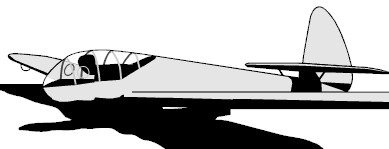
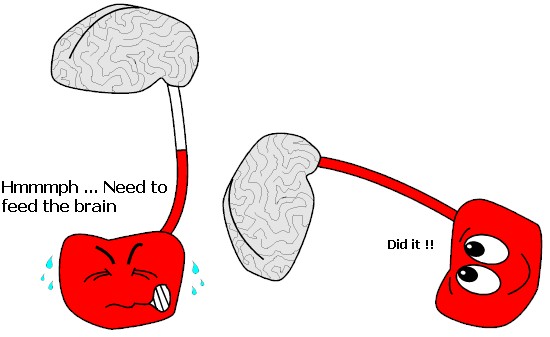
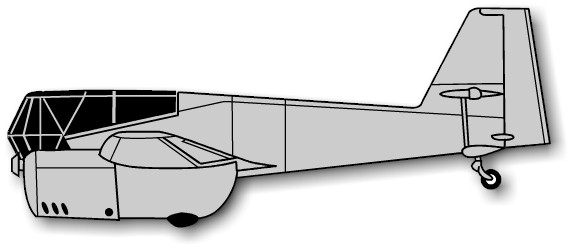
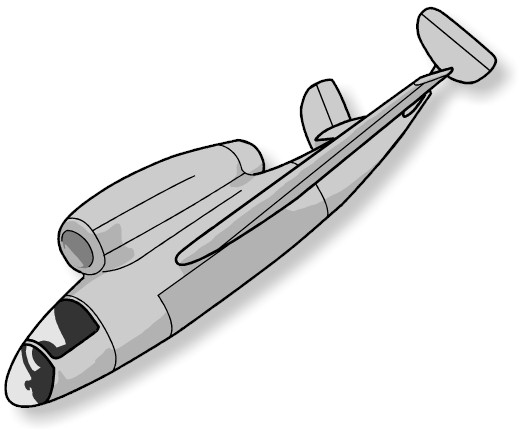
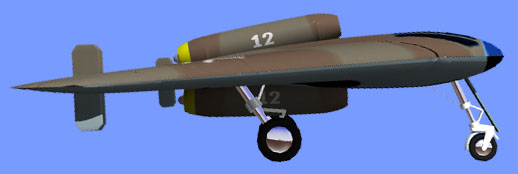

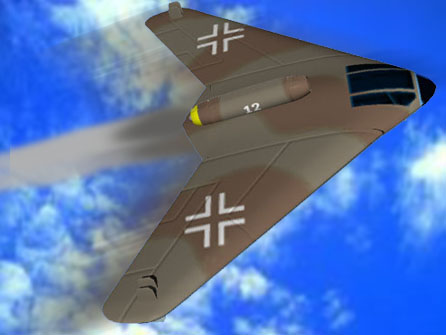
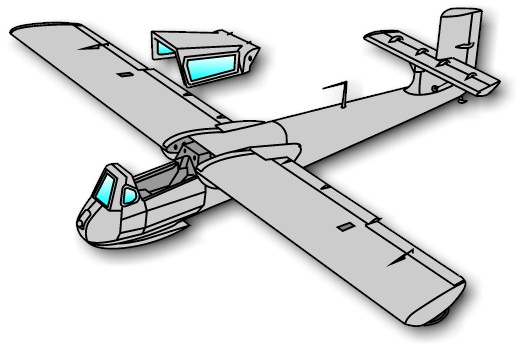
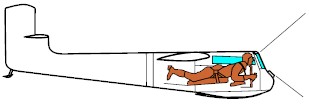
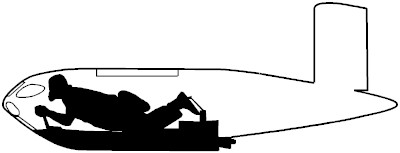


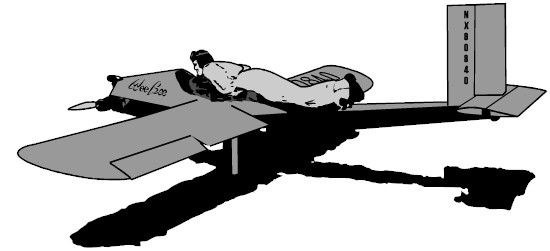
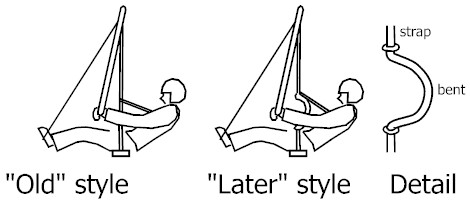
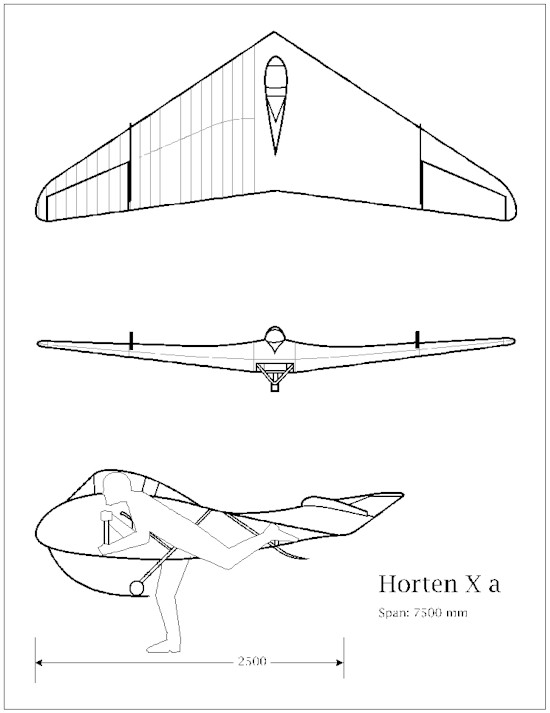
.jpg)
